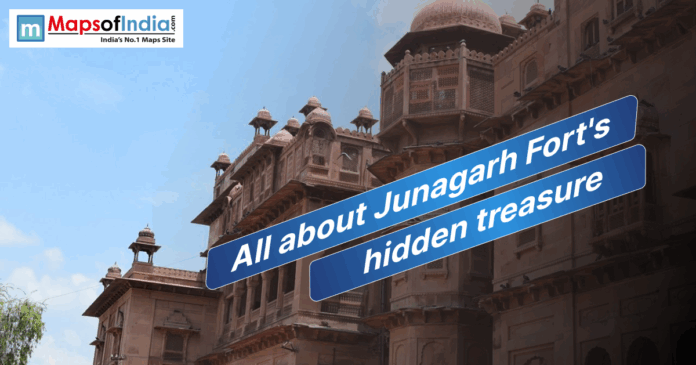Junagarh Fort, situated in Bikaner, Rajasthan, is steeped in mystery. This fort was built in 1589. This fort can be seen as a marvel of Rajput architecture. Tales of hidden treasure spark intrigue about this fort. As per this tale, whispers of gold and jewels stashed by royals are hidden in this fort. Despite its grandeur, the fort’s secrets remain elusive. These tales are attracting historians and tourists to this fort. No verified treasure has been found here. Yet the curiosity of people attracts many people toward this fort.
Historical Context of Junagarh Fort
Junagarh Fort was built by Raja Rai Singh. The construction of this fort began in 1589, and the fort was completed in 1594. The Rajput king Rai Singh was a Mughal general who served under Akbar. Rai Singh’s wealth from jagirs funded the construction of the fort. This fort is not like most Rajasthani forts, it sits on flat land. This fort is expanded in a 5.28-hectare area. In this fort, palaces like Anup Mahal are there. The fort withstood many enemy attacks, except for a one-day siege in 1534. Treasure tales tied to Rai Singh’s riches are really famous about this fort. His Mughal alliances brought him immense wealth. This fueled speculation of hidden vaults. The fort’s history sets the stage for treasure myths.
Legends of Hidden Treasure
Treasure stories surrounding Junagarh Fort are well known. Local lore tells about gold and silver caches. These tales are mentioned on the news channel many times. Raja Rai Singh’s wealth spread these rumours. Some adventurous people believe that he hid riches in the secret chambers of this fort. Others claim later rulers added to the hoard. Many believe that these treasures were buried for safety. The fort’s moat and thick walls give the vibe of protection. There are no historical records present that can confirm these claims. They might be just folklore. Hidden rooms and tunnels add fuel to this speculation. Artisans’ wealth from the Gujarat campaigns is cited. These legends draw treasure hunters. They remain unproven but enduring.
Architectural Features and Secret Spaces
The design of the Junagarh Fort gives the vibe of secrets hidden there. The layout of this fort includes 37 ramparts and seven gates. This place is an intricate palace. Anup Mahal inside the fort has gold-plated designs. Phool Mahal has some mirror work. There are many hidden passages in the fort. People believe these could conceal treasure. The fort’s moat spans 986 yards. The walls of this fort are sandstone. Some speculate vaults lie beneath courtyards. Others point to the Badal Mahal’s cellars. There is no concrete archaeological proof present. Some believe that Fort’s museum holds clues. Artefacts like weapons suggest wealth. The architecture fuels treasure myths. Its complexity hides potential secrets.
Historical Attempts to Find Treasure
Attempting treasure hunts at Junagarh Fort is rare. Unlike Jaigarh Fort, no major searches are recorded. To find the hidden treasure, there was a treasure hunt in 1976. In the time of emergency, Indira Gandhi ordered this hunt. Junagarh lacks similar documented raids. Many locals tried to find treasure here. Small-scale digs by treasure hunters always resulted in failure. In search of hidden treasure, many illegal excavations took place in the fort. These illegal excavations caused damage to the fort’s walls. No significant finds were made in this effort. The fort’s museum, which was opened in 1961, holds many artefacts. These artefacts point toward wealth, but there is no mention of hidden troves. Lack of evidence keeps the treasure elusive. Searches remain speculative.
Connection to Jaigarh Fort’s Treasure Myths
Junagarh’s treasure tales echo Jaigarh’s. Many believe that the tales of the two forts’ treasure are connected. Jaigarh’s 1976 treasure hunt was mainly looking for Man Singh’s Afghan loot. According to folklore, many believe that he hid gold in Amber Fort. There is a tunnel that connects Jaigarh to Amber. There is no such tunnel in Junagarh Fort. But the stories of treasure are similar to the Jaigarh’s. In the Jaigarh fort, tanks were found. But only 230 kg of silver was found. The treasure tales of Junagarh lack specifics. Junagarh’s myths may be inspired. Both forts share Rajput wealth lore. This connection fuels regional treasure fascination.
Cultural and Touristic Impact
Treasure tales boost tourism in Junagarh’s fort. Tourists flock to its museums and palaces. To complete the visit to this fort, 2 to 3 hours are required. More than 100,000 tourists visit this fort yearly. Guides share treasure stories with the tourists. These stories enhance the tour experience. The fort’s museum displays weapons and jewellery. These hint at royal riches. The entry fee to the fort is Rs. 50 for Indians, Rs. 300 for foreigners. The myths around the treasure add mystique to this place. These tales make the Junagarh fort a cultural gem. Visitors want to experience history and intrigue. The fort’s legacy thrives on these tales.
Modern Perspectives and Preservation
The way of attracting tourists for treasure hunts raises the question of ethical concerns. This can cause various damages to the fort. Illegal digging for treasure harms Junagarh’s structure. The fort is a protected monument. This historical monument should be preserved. No official treasure searches are planned. The artefacts found in this fort include Mughal-era coins. These artefacts suggest there was wealth but no hidden treasure. Modern technology like ground-penetrating radar is unused. Preservation focuses on architecture. The tales related to the treasure are folklore, not fact. Protecting the heritage of Junagarh Fort is important. Its cultural value outweighs unverified riches.
Conclusion
The treasure tales of the Junagarh fort are captivating mysteries that stretch your imagination. This fort was built in 1589 and is called a Rajput masterpiece. It stands as a Rajput icon. Raja Rai Singh’s wealth adds fuel to these rumours. Legends of gold and jewels exist in this fort. The fort’s design gives the vibe of hiding potential secrets. Guides amplify these treasure stories for tourists. No treasure has been found. Yet the allure exists. Due to this, this place draws adventurers. Many visitors who are dreamers are regular at this fort. The fort’s grandeur supports these tales. They blend history with mystery. Junagarh remains a treasure-hunting dream. Its legacy thrives on intrigue.





